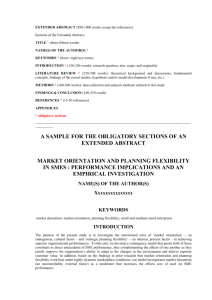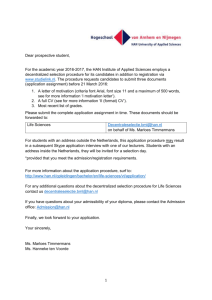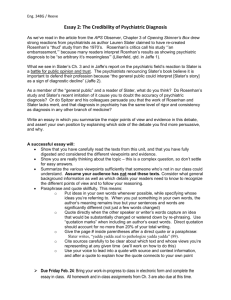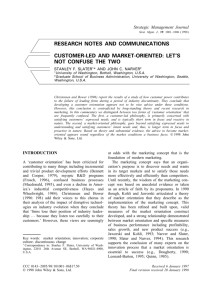Market Orientation, Innovation Capability and Business
advertisement
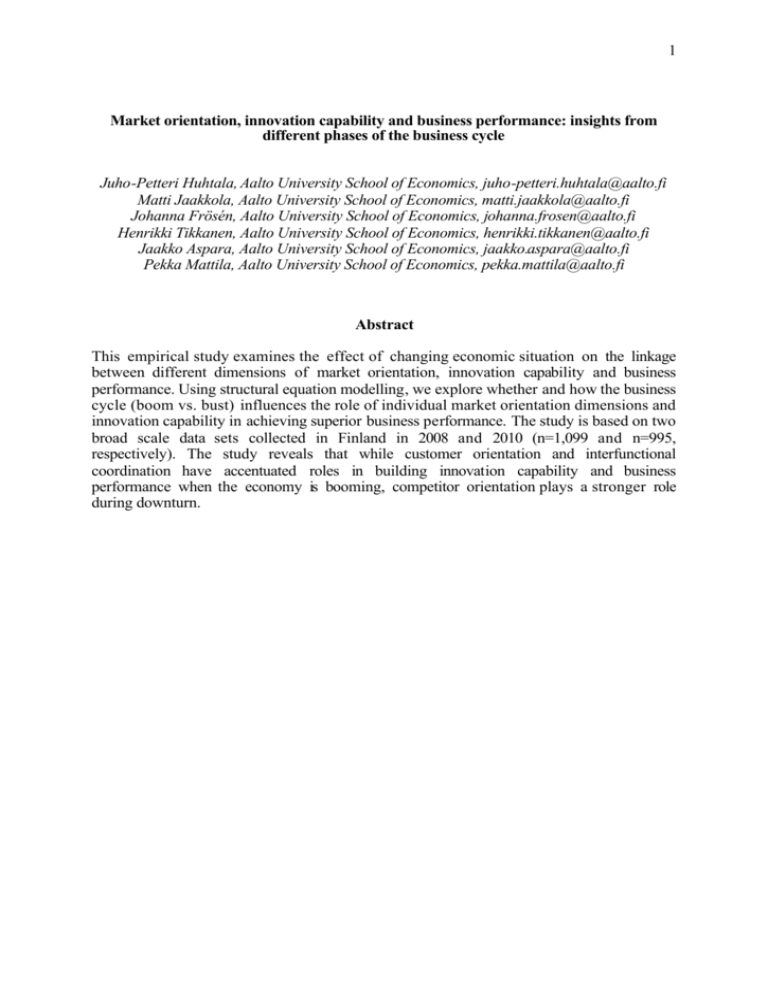
1 Market orientation, innovation capability and business performance: insights from different phases of the business cycle Juho-Petteri Huhtala, Aalto University School of Economics, juho-petteri.huhtala@aalto.fi Matti Jaakkola, Aalto University School of Economics, matti.jaakkola@aalto.fi Johanna Frösén, Aalto University School of Economics, johanna.frosen@aalto.fi Henrikki Tikkanen, Aalto University School of Economics, henrikki.tikkanen@aalto.fi Jaakko Aspara, Aalto University School of Economics, jaakko.aspara@aalto.fi Pekka Mattila, Aalto University School of Economics, pekka.mattila@aalto.fi Abstract This empirical study examines the effect of changing economic situation on the linkage between different dimensions of market orientation, innovation capability and business performance. Using structural equation modelling, we explore whether and how the business cycle (boom vs. bust) influences the role of individual market orientation dimensions and innovation capability in achieving superior business performance. The study is based on two broad scale data sets collected in Finland in 2008 and 2010 (n=1,099 and n=995, respectively). The study reveals that while customer orientation and interfunctional coordination have accentuated roles in building innovation capability and business performance when the economy is booming, competitor orientation plays a stronger role during downturn. 2 Introduction During the past two decades, the concept of market orientation (MO) (e.g. Narver and Slater, 1990; Kohli and Jaworski, 1990) has become an essential part of contemporary marketing thought. Several academicians have been interested in the potential consequences of MO (van Raaij and Stoelhorst, 2008), and its relation to business performance in particular. The vast majority of the studies conclude that MO positively affects companies’ business performance (Kirca, Jayachandran and Bearden 2005; Ellis, 2006). On the other hand, less attention has been paid to how MO translates into performance. Slater and Narver (1994b) and Han, Kim and Srivastava (1998) were among the first authors to suggest that innovation might be the missing link in the MO-performance relationship. Though a few recent studies (e.g. Murray, Gao and Kotabe, 2010; De Luca, Verona and Vicari, 2010; Langerak, Hultink and Robben, 2007) have further examined this suggestion, the resulted evidence remains inconclusive. In the present study, we, therefore, aim to examine whether innovation capability is the mechanism that transforms MO into superior performance (Han et al. 1998; Hurley and Hult, 1998). In doing so, we use the three dimensions of MO – customer orientation, competitor orientation and interfunctional coordination (Narver and Slater, 1990) – as antecedents to innovation capability that further affects business performance. This is also a step toward a more detailed analysis of the performance implications of MO, as most of the previous studies treat MO as a one-dimensional entity. Prior research (e.g. Jaworski and Kohli, 1993; Slater and Narver, 1994a; Harris, 2001; Murray et al. 2010) has proposed that contextual factors, such as market and technological turbulence and competitive intensity, moderate the strength of the relationship between MO and business performance (for a meta-analysis, see Kirca et al. 2005). In this study, we examine the impact of MO in Finnish companies in two essentially different business contexts: in 2008, before the global economic crisis, and in 2010, during the economic downturn. Comparing the 2008 and 2010 data sets, we gain insights into the role of different dimensions of MO and innovation capability during a boom and a bust. Apart from the study by Noble, Sinha and Kumar (2002), examining the relative performance effects of various dimensions of MO with a longitudinal approach, ours is – to our best knowledge – the first study that longitudinally investigates the impact of the business cycle on the MO-innovation-performance interplay, thereby addressing a significant gap in previous research. Theoretical background and hypotheses development Several scholars (e.g. Slater and Narver, 1994b; Han et al., 1998) have suggested innovation to play a crucial role in the MO - business performance relationship. This is because MO leads firms to adopt an external focus to innovation, which finally allows them to achieve and sustain superior performance (Slater and Narver, 1994b). Firms with innovative capability supported by MO also possess an ability to respond more rapidly to changes in the business environment (Gatignon and Xuereb, 1997). Adopting the perspective of MO originally introduced by Narver and Slater in 1990, a majority of contemporary studies approach MO as a three-dimensional concept, consisting of customer orientation, competitor orientation and interfunctional coordination (e.g. Lukas and Ferrell, 2000; Morgan, Vorhies and Mason, 2009). However, later studies have shown that roles of different MO dimensions might vary in different contexts (Han et. al, 1998). Therefore, in this study, we examine the effects of the three distinctive dimensions of MO separately. 3 Competitor orientation refers to understanding competitors and their strategies, and to developing appropriate responses to competitors’ actions (Gatignon and Xuereb, 1997). Some researchers argue that competitor orientation is a source of product imitation (e.g. Hayes and Abemathy 1980; Zahra, Nash and Bickford, 1995), and, therefore, results in a negative impact on innovation capability (Lukas and Ferrell, 2000). Still, most scholars suggest that competitor-oriented culture enhances innovation, as it can be used to develop products differentiated from those of competitors (Han et al., 1998; Im and Workman, 2004; Grinstein, 2008), and it serves as a stimulus to gain a leading position in the market (Bozic, 2006). In line with most of MO literature, we hypothesize that: Competitor orientation has a positive impact on the innovation capability of the firm (H1a). Customer orientation requires a sufficient understanding of the customer in order to create superior products or services (Narver and Slater, 1990). Some researchers argue that customer orientation occasionally thwarts innovative R&D and product development, as listening to customers too carefully may lead the firm to focusing only on current needs (Christensen and Bower, 1996). However, a contrary view holds that customer orientation may essentially enhance innovativeness (Gatignon and Xuereb, 1997; Han et al., 1998), since it encourages firms to uncover latent customer needs (Narver, Slater and MacLachlan, 2004). On MO component-level studies, Appiah-Adu and Singh (1998), Kahn (2001), Gatignon and Xuereb (1997) and Grinstein (2008) found a positive relationship between customer orientation and innovation. Thus, based on the majority of extant literature, we hypothesize that: Customer orientation has a positive impact on the innovation capability of the firm (H1b). Interfunctional coordination is the mechanism that enables all departments of a rm to cooperate in achieving customer and competitor orientation (Gatignon and Xuereb, 1997; Narver and Slater, 1990). It also increases dependency and mutual trust among employees in different functions such as marketing, sales and R&D (Olson, Walker, Orville and Ruekert, 1995). Earlier studies suggest interfunctional coordination to influence new product decisions directly (Atuahene-Gima, 1996). Evidence suggests this impact to be positive, since interfunctional coordination enhances information sharing and joint problem solving (Gatignon and Xuereb, 1997). It has also been argued that excessive information sharing may have a negative impact on innovation capability (Henard and Szymanski, 2001). Nevertheless, information sharing is identified as essential for product development (Im and Workman, 2004; Han et al., 1998). In line with prior research, we hypothesize that: Interfunctional coordination has a positive impact on the innovation capability of the firm (H1c). According to Schumpeter (1950), innovation is an important source of competitive advantage, and, therefore, a determinant of superior business performance. This view is strongly supported in the empirical studies of organizational innovation, focused on the relationship between innovation and business performance (e.g. Damanpour, Szabat and Evan, 1989; Han et al., 1998). The logic behind this relation is that innovations serve as a ‘coping mechanism’ for environmental uncertainty (Damanpour and Evan, 1984; Han et al., 1998). Firms with high innovation capability encourage their members to develop innovative offerings in order to cope with environmental change, eventually leading to superior performance. Since a direct positive link between innovation and business performance has been frequently established in extant literature (Damanpour et al. 1989; Han et al., 1998), we hypothesize that: Innovation capability has a positive impact on the business performance of the firm (H2). 4 The three described MO dimensions are not always equally important (Lukas and Ferrell, 2000), since e.g. the level of environmental change may affect each of the dimensions differently (Han et. al, 1998). However, the findings regarding the significance of different dimensions of MO found in different environmental contexts varies significantly across studies (cf. Han et. al, 1998; Gatignon and Xuereb, 1997; Noble et al., 2002). With the highly controversial findings of these prior studies, we hypothesize that: During the different phases of the business cycle, the link between the different dimensions of the MO construct and innovation capability varies to a considerable extent (H3). Methodology The two data sets were collected by online questionnaires in 2008 and 2010. Year 2008 essentially represents time of economic upturn, while in 2010 international markets were faced with a significant economic downturn. For example, between 2008 and 2009, the Finnish GDP reduced by massive 7.8 percent (Statistics Finland, 2010). Simultaneously, value-added volume in primary production was reduced by 5.5 percent, while private consumption and retail sales also slumped (Statistics Finland, 2010; Bank of Finland, 2010). In 2008, a pilot version of the questionnaire was sent to 114 managing directors, of whom 34 completed the questionnaire. The pre-tested survey was then addressed to top management in all Finnish companies with more than five employees, derived from a commercial database. Accordingly, our data contain companies from all industries, sizes and types. Usable responses from 1 099 companies were received in 2008, corresponding to the response rate of 16.0%. In 2010, the questionnaire was completed in 995 firms. Considering the high positions of the respondents (mostly CEOs or equivalent), the response rate was considered adequate. To test the hypothesized relationships, we selected a sample that consists only of firms that responded to both of the surveys (n=269). Non-response bias was tested through analysis of mean scores on the survey items for early versus late respondents (Armstrong and Overton, 1977). Using t-tests at the 0.05 level, no significant differences were found. Three multi-item constructs are used in this study: market orientation, innovation capability, and business performance. The frequently used scale of Narver and Slater (1990) was deployed to measure the three dimensions of MO. For measuring companies’ innovation capability, we constructed a four-item scale, adapted from Zou, Fang and Zhao (2003). The three subjective performance metrics chosen (profit, ROI and market share) have been used in several studies (e.g. Morgan et. al, 2009; O’Sullivan and Abela, 2007). All the items were measured in a seven-point Likert scale format. Results Confirmatory factor analysis (CFA) was used for scale construction and validation. Reliability measures and the correlation matrix for the latent variables are shown in Tables 1 and 2. Accordingly, all composite reliabilities (CR) and average variance extracted (AVE) indexes are above the respective thresholds of 0.6 and 0.5 (Diamantopoulos and Siguaw, 2000). Sufficiently high factor loadings (threshold 0.60) and CRs suggest high convergent validity, while finding that all the square roots of the AVE for a given construct are greater than the corresponding correlations with any other construct in the analysis (Tables 1 and 2). Thus, support for discriminant validity is provided (Fornell and Larcker, 1981). 5 Table 1 Construct correlations and descriptive statistics of measures (2008) Construct Mean SD AVE CR 1 2 3 4 5 1. Business performance 3.43 1.63 0.76 0.90 0.87 2. Competitor orientation 3.25 1.31 0.56 0.79 0.20 0.75 3. Customer orientation 2.82 1.33 0.52 0.88 0.17 0.66 0.72 4. Interfunctional coordination 3.15 1.41 0.56 0.83 0.17 0.68 5. Innovation capability 3.27 1.17 0.63 0.87 0.40 0.32 Square-root of average variance extracted (AVE) on the diagonal in bold; correlations off-diagonal 0.73 0.43 0.75 0.45 0.79 3 4 5 0.73 0.31 0.80 Table 2 Construct correlations and descriptive statistics of measures (2010) Construct Mean SD AVE CR 1 2 1. Business performance 3.48 1.56 0.62 0.83 0.79 2. Competitor orientation 3.24 1.48 0.53 0.82 0.40 0.73 3. Customer orientation 2.64 1.25 0.55 0.86 0.23 0.59 0.74 4. Interfunctional coordination 5. Innovation capability 3.16 3.52 1.53 1.50 0.53 0.63 0.82 0.87 0.30 0.33 0.65 0.42 0.68 0.31 To test the hypotheses, we analysed a series of structural equation models by using the Partial Least Squares (PLS) method (Fornell and Cha, 1994). We chose to use PLS as it does not assume homogeneity in the observed population, and therefore is more suitable for real world applications (Wu, 2010). The results from this analysis are illustrated in Figure 1. Competitor orientation -.01 n.s. (.07) .35 ** (2.74) Customer orientation .26 * (2.06) .09 .27 * n.s. Innovation capability (.97) .40 *** (4.44) .33 *** Business performance (3.72) (2.24) Inter-functional n.s. coordination .02 (.17) Note: Standardized coefficients are reported with t-values in parentheses * p < 0.05; **p < 0.01; *** p < 0.001; n.s. = non-significant Figure 1 Results of the analysis from 2008 (underlined) and 2010 The 2008 (2010) model explains 22.5 % (18.2. %) of innovation capability and 15.6 % (11.2 %) of business performance. Goodness-of-t index (GoF) was calculated using Tenenhaus, Esposito Vinzi, Chatelin and Lauro’s (2005) global fit measure for PLS. According to the categorization of R² effect sizes by Cohen (1988) and using 0.50 as cut-off value for communality (Fornell and Larcker, 1981), in the 2008 (2010) model, the GoF was 0.34 (0.29), indicating good fit of the model to the data (Schepers, Wetzels and de Ruyter, 2005). In general, the results indicate strong differences in the roles of individual MO dimensions in different phases of business cycle, thus providing support to H3. While we did not find statistically significant evidence for the positive link between competitor orientation and innovation capability in 2008, the opposite applied to 2010 (p<0.01). Therefore, hypothesis 6 H1a was supported for 2010, but not for 2008. Furthermore, customer orientation and interfunctional coordination positively (p<0.05) influenced innovation capability in 2008, but in 2010 the relationship was non-significant. Hypotheses H1b and H1c are thus supported only for 2008. Finally, positive linkage between innovation capability and business performance was found in both of the models (p<0.001), providing general support for H2. Discussion and conclusions This paper contributes to the discussion on the role of innovation capability in mediating the effect of market orientation on business performance. Firstly, well in line with previous studies (Slater and Narver 1994b; Atuahene-Gima, 1996; Han et al., 1998; Hult, Hurley and Knight, 2004; Olavarrieta and Friedman, 2008), the role of innovation capability as an essential component in translating MO into business performance was validated. Secondly, expanding the scope of previous studies, empirical evidence on the varying role of different dimensions of MO was provided. In particular, our findings suggest customer orientation and interfunctional coordination to play an accentuated role in building innovation capability and achieving solid business performance when the economy is booming, whereas competitor orientation was found to play a more significant role during downturn. Thus, thirdly, business cycle was found to moderate the way in which the different MO dimensions are emphasized in enhancing innovation capability and business performance. In practice, our findings suggest a shift of managerial focus from generating long term value during a boom to more short-term survival considerations during a recession. In a growing economy or market, competitors are allowed to grow hand in hand, whereas when facing tightening competition in declining markets, growth has to be gained from gobbling up competitors’ market share. Therefore, from a managerial perspective, this study provides implications for focusing investments in different dimensions of MO over the business cycle. Essentially, it seems that during a boom, companies would benefit from focusing on building customer orientation and enhancing interfunctional coordination. On the other hand, during a bust, superior performance could be achieved by directing investments to enhancing competitor orientation. In terms of possible limitations, cross-sectional data does not capture the sequential, temporal order of causality or dynamics that the models like ours conceptually assume. As in any study considering cause-and-effect relationships, the direction of causality is therefore an issue to consider. For example, it might be argued that higher business performance actually generates MO and not vice versa. Following the recent studies of e.g. Ramaswami, Bhargava and Srivastava (2009), Morgan et al. (2009) and Gatignon and Xuereb (1997), testing whether interactions of the three MO dimensions help further build innovation capability and firm performance would also further enhance implications drawn from the study. Also, although the data used in the study is considered to be representative of the Finnish business environment, any generalization beyond the Finnish context should be drawn with caution. Moreover, our dataset included companies with various characteristics (in terms of e.g. size, age, industry), operating in a variety of different business contexts. However, e.g. Cano et al. (2004) have found stronger relationships between MO and business performance for not-for-profit compared to for-profit firms and service compared to manufacturing firms. An interesting topic to be researched further would thus include comparing findings acquired from more limited data sets, concentrating on specific sectors or industries. 7 References Appiah-Adu, K., Singh, S., 1998. Customer orientation and performance: a study of SMEs. Management Decision 36 (6), 385-394. Armstrong, J.S., Overton, T.S., 1977. Estimating Non-Response Bias in Mail Surveys. Journal of Marketing Research, 14, 396-402. Atuahene-Gima, K., 1996. Market orientation and innovation. Journal of Business Research 35 (2), 93–103. Bozic, L., 2006. The effects of market orientation on product innovation. Economic Trends and Economic Policy 107, 46–65. Brodie, R.J., Danaher, P.J., 2000. Building models for marketing decisions: Improving empirical procedures. International Journal of Research in Marketing 17 (2-3), 135-139. Cano, C.R., Carrillat, F.A., Jaramillo, F., 2004. A meta-analysis of the relationship between market orientation and business performance: evidence from five continents. International Journal of Research in Marketing 21 (2), 179-200. Christensen, C.M., Bower, J.L., 1996. Customer power, strategic investment, and the failure of leading firms. Strategic Management Journal 17 (3), 197-218. Cohen, J., 1988. Statistical power analysis for the behavioural sciences, Lawrence Erlbaum Associates, New York. Damanpour, F., Szabat, K.A., Evan, W.M., 1989. The Relationship Between Types of Innovation and Organizational Performance. Journal of Management Studies 26 (6), 587-601. Damanpour, F., Evan, W.M. 1984., Organizational Innovation and Performance: The Problem of 'Organizational Lag'. Administrative Science Quarterly 29 (3), 392-409. De Luca, L.M., Verona, G., Vicari, S., 2010. Market Orientation and R&D Effectiveness in High-Technology Firms: An Empirical Investigation in the Biotechnology Industry. Journal of Product Innovation Management. 27 (3), 299–320. Diamantopoulos, A., Siguaw, A., 2000. Introducing Lisrel: A guide for the uninitiated, SAGE Publications, London. Ellis, P.D., 2006. Market Orientation and Performance: A Meta-Analysis and Cross-National Comparisons. Journal of Management Studies 43 (5), 1089–1107. Fornell, C., Larcker, D.F., 1981. Evaluating structural equation models with unobservable variables and measurement error. Journal of Marketing Research 18 (1), 39–50. Gatignon, H., Xuereb, J.M., 1997. Strategic orientation of the rm and new product performance. Journal of Marketing Research 34 (1), 77–79. 8 Grinstein, A., 2008. The effect of market orientation and its components on innovation consequences: a meta-analysis. Journal of the Academy of Marketing Science 36 (2), 166173. Han, J.K., Kim, N., Srivastava, R., 1998. Market orientation and organizational performance: Is innovation a missing link? Journal of Marketing 62 (4), 30−45. Harris, L.C., 2001. Market orientation and performance: Objective and subjective empirical evidence from UK companies. Journal of Management Studies 38 (1), 17–43. Hayes, R.H., Abemathy, W.J., 1980. Managing our way to economic decline. Harvard Business Review 58 (4), 67–77. Henard, D.H., Szymanski, D.M., 2001. Why some new products are more successful than others? Journal of Marketing Research 38 (3), 362-375. Hult, G.T.M., Hurley, R.F., Knight, G.A., 2004. Innovativeness: Its antecedents and impact on business performance. Industrial Marketing Management 33 (5), 429-438. Hurley, R.F., Hult, T., 1998. Innovation, Market Orientation, and Organizational Learning: An Integration and Empirical Examination. Journal of Marketing 62 (3), 42-54. Im S., Workman, J., 2004. Market orientation, creativity, and new product performance in high-technology firms. Journal of Marketing 68 (2), 114-132. Jaworski, B.J., Kohli, A.K., 1993. Market orientation: Antecedents and consequences. Journal of Marketing 57 (3), 53–70. Kahn, K.B., 2001. Market Orientation, InterdepartmentalIntegration, and Product Development Performance. Journal of Product Innovation Management 18 (5), 314–323. Kirca, A.H., Jayachandran, S., Bearden, W.O., 2005. Market Orientation: A Meta-Analytic Review and Assessment of Its Antecedents and Impact on Performance. Journal of Marketing 69 (2), 24-41. Kohli, A.K., Jaworski, B.J., 1990. Market orientation: The construct, research propositions, and managerial implications. Journal of Marketing 54 (2), 1-18. Langerak, F., Hultink, E.J., Robben, H.S.J., 2007. The mediating role of new product development in the link between market orientation and organizational performance. Journal of Strategic Marketing 15 (4), 281 – 305. Lukas, B.A., Ferrell, O.C., 2000. The effect of market orientation on product innovation. Journal of the Academy of Marketing Science 28 (2), 239-247. Morgan, N.A., Vorhies, D.W., Mason C.H., 2009. Market orientation, marketing capabilities, and firm performance. Strategic Management Journal 30 (8), 909-920. 9 Murray, J.Y., Gao, G.Y., Kotabe, M., 2010. Market orientation and performance of export ventures: the process through marketing capabilities and competitive advantages. Journal of the Academy of Marketing Science. Forthcoming. Narver, J.C., Slater, S.F., 1990. The Effect of a Market Orientation on Business Profitability. Journal of Marketing 54 (4), 20–35. Narver, J.C., Slater, S.F., MacLachlan, D.L., 2004. Responsive and Proactive Market Orientation and New-Product Success. The journal of product innovation management 21 (5), 334-374. Noble, C., Sinha, R., Kumar, A., 2002. Market orientation and alternative strategic orientations: A longitudinal assessment of performance implications. Journal of Marketing 66 (4), 25−39. O'Sullivan, D., Abela, A.V., 2007. Marketing performance measurement ability and firm performance. Journal of Marketing 71 (2), 79-93. Olavarrieta, S., Friedmann, R., 2008. Market orientation, knowledge-related resources and firm performance. Journal of Business Research 61 (6), 623-630. Olson, E., Walker, O.C., Ruekert, R.W., 1995. Organizing for Effective New Product Development: The Moderating Role of Product Innovativeness 59 (1), 48-62. Ramaswami, S.N., Srivastava, R.K., Bhargava, M., 2009. Market-based capabilities and financial performance of firms: insights into marketing’s contribution to firm value. Journal of the Academy of Marketing Science 37, 97-116. Schepers, J., Wetzels, M., de Ruyter, K., 2005. Leadership styles in technology acceptance: Do followers practice what leaders preach? Managing Service Quality 15 (6), 496–508. Schumpeter, J., 1950. Capitalism, socialism and democracy, Harper and Row, New York. Slater, S.F., Narver, J.C., 1994a. Market orientation, customer value, and superior performance. Business Horizons 37 (2), 22-28. Slater, S.F., Narver, J.C., 1994b. Does competitive environment moderate the market orientation-performance relationship? Journal of Marketing 58 (1), 46-55 Tenenhaus, M., Esposito Vinzi, V., Chatelin, Y.-M., Lauro, C. 2005. PLS path modeling. Computational Statistics & Data Analysis 48 (1), 159–205. Van Raaij, E.M., Stoelhorst, J.W., 2008. The Implementation of a Market Orientation: A Review and Integration of the Contributions to Date. European Journal of Marketing 42 (11/12), 1265-1293. Wu, W.W., 2010. Linking Bayesian networks and PLS path modeling for causal analysis. Expert Systems with Applications 37 (1) 134–139. 10 Zahra, S.A., Nash, S., Bickford, D.J., 1995. Transforming technological pioneering into competitive advantage. Academy of Management Executive 9 (1), 17–31. Zou, S., Fang, E., Zhao, S., 2003. The effect of export marketing capabilities on export performance: An investigation of Chinese exporters. Journal of International Marketing 11 (4), 32-55.

